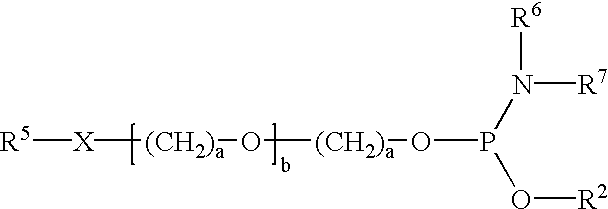Mobility-modified nucleobase polymers and methods of using same
a technology of nucleobase polymers and mobility modifications, which is applied in the field of nucleobase polymer functionalizing reagents, can solve problems such as homogeneous products, and achieve the effects of reducing the number of available mobility modifications, and increasing the repertoire of available mobility modifications
- Summary
- Abstract
- Description
- Claims
- Application Information
AI Technical Summary
Benefits of technology
Problems solved by technology
Method used
Image
Examples
example 1
Synthesis of DMT-Protected Poly(ethylene oxide) Alkyl Phosphoramidite
Bis(diisopropylamino)chlorophosphine was synthesized by reacting phosphorous trichloride and diisopropylamine in toluene. Fifty ml of the resulting bis(diisopropylamino)phosphine was placed in a 250 ml flask and 3.01 ml of ethanol added slowly over a two minute period and the reaction allowed to proceed for several days. After filtering the mixture and removing the solvent, the structure of the bis(diisopropylamino)ethylphosphite ester reagent was analyzed by .sup.31 P and .sup.1 H NMR (.sup.31 P NMR in CD.sub.3 CN 125.9 ppm).
Mono dimethoxytrityl (DMT) protected pentaethylene oxide (3.0 gm, 5.5 mmole) tetrazole diisopropylamine salt (0.095 gm, 0.055 mmole) were dissolved in 10 ml of methylene chloride and reacted with bis(diisopropylamino)ethylphosphite ester (1.75 gm, 7.2 mmole) for 15 hours. The phosphoramidite product, DMT-pentaethyleneoxide ethyl-N,N-diisopropylphosphoramidite, was washed two times with saturat...
example 2
Synthesis of Mobility-Modified Sequence-Specific Nucleobase Polymers
Sequence-specific nucleobase polymers labeled at the 3'-nucleoside with tetramethyl rhodamine were synthesized on a Applied Biosystems 394 synthesizer using standard phosphoramidite chemistry. To synthesize mobility-modifying nucleobase polymers, the phosphoramidite reagents of Example 1 were reacted with the 5' OH end of the immobilized nucleobase polymer. Subsequent oxidation with iodine and deprotection with base converts .beta.-cyanoethylphosphite linkages to phosphate diester linkages while ethyl phosphite linkages are converted to ethyl phosphate triester linkages. After cleavage from the solid support and deprotection with base at 55.degree. C. for 4 hrs, the nucleobase polymers were purified by high performance liquid chromatography (HPLC). Treatment with 100 .mu.l of 80% acetic acid for 15 min removed the final DMT protecting group. The mobility-modified nucleobase polymers were purified on a PD 10 column.
example 3
Separation Characteristics of Mobility-Modified Sequence-Specific Nucleobase Polymers
A series of twelve-residue nucleobase polymers ("12 mers") were synthesized to which were attached different mobility-modifying monomeric units of pentaethylene oxide via either charged phosphate diester (PEO) or uncharged ethyl phosphate triester (PEE) linkages, which were synthesized as set forth in Example 2. The relative electrophoretic mobility profile for each compound was evaluated by separation by capillary electrophoresis in a non-sieving medium (Applied Biosystems 310 Genetic Analyzer). Fluorescent internal size standards provided the reference markers for peak retention analysis using GeneScan.RTM. software.
An unmodified 12-mer nucleobase polymer migrates with an apparent base size of 24.7. Attachment of three units of pentaethylene oxide covalently linked to the nucleobase polymer moiety through negatively charged phosphate diester linkages, retards the mobility of the 12 mer by 5.3 base...
PUM
| Property | Measurement | Unit |
|---|---|---|
| molecular weight | aaaaa | aaaaa |
| molecular weight | aaaaa | aaaaa |
| temperature | aaaaa | aaaaa |
Abstract
Description
Claims
Application Information
 Login to View More
Login to View More - R&D
- Intellectual Property
- Life Sciences
- Materials
- Tech Scout
- Unparalleled Data Quality
- Higher Quality Content
- 60% Fewer Hallucinations
Browse by: Latest US Patents, China's latest patents, Technical Efficacy Thesaurus, Application Domain, Technology Topic, Popular Technical Reports.
© 2025 PatSnap. All rights reserved.Legal|Privacy policy|Modern Slavery Act Transparency Statement|Sitemap|About US| Contact US: help@patsnap.com



